Ads help pay for the hosting and maintenance of this site. Thank you for visiting!
Welcome to Sky Diary Kidstorm!
This page talks about what storm chasing is really like, how storm chasers find storms, if “Twister” is anything like real storm chasing, how to become a storm chaser and more.
TOPICS: all about storm chasers | a typical chase | “Twister” and reality | how to become a storm chaser | storm chasing links
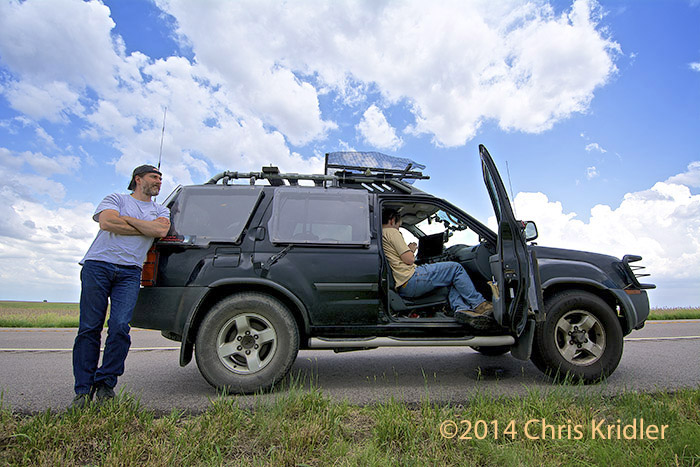
Scott McPartland and Dave Lewison hang out, watching a budding storm, during a chase in 2014. Their vehicle has shields on the windows to prevent hail damage. (c)2014 Chris Kridler
All about storm chasers
Storm chasers are people who try to get close to storms for the purposes of observation or science. A couple of chasers began chasing storms in the 1940s and 1950s, an amazing feat when you consider how little information was available for them to figure out where the storms were. Now, many – but not all – storm chasers travel with laptop computers or tablets. Sometimes they have anemometers (for measuring wind), portable weather stations and other equipment, and they usually carry a variety of video and still cameras.
It’s hard to say how many chasers there are, but there are at least several hundred serious ones. (The excellent Storm Track FAQ on chasing is a little outdated when it comes to the numbers; including storm tourists but not including casual observers with cell phones, the number could be a thousand or more.) There are a number of storm-chasing tours now (some have been around for many years, including Cloud 9 Tours and Tempest Tours), which bump up the number a lot.
When some people find out you’re a storm chaser, they say, “That’s a cool job!” But it’s a job for very few chasers. Only scientists and a few photographers, tour operators and TV stars can make a living chasing storms, and even then, chasing is seasonal. Some chasers sell video or photographs to help pay for the hobby, which can be very expensive after chasers pay for gasoline, car maintenance, hotels, food, Internet connections, data-gathering equipment and so on.
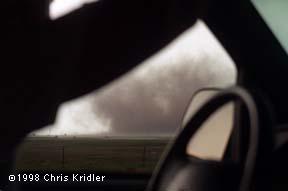
On May 24, 1998, a chase vehicle gets close to a tornado near Medford, Oklahoma. (c)1998 Chris Kridler
Yes, there’s a lot of gasoline involved, and that’s because a storm chaser can cover hundreds of miles a day, or three or four thousand miles a week! Storm chasing rarely involves an easy drive. On one day, a chaser might be in Iowa. The next, in western Nebraska. The next, in the Texas panhandle. And there is no guarantee of seeing anything. Many hours of driving can result in nothing but a blue sky or a few rain showers. A tornado is a rare event and may appear in only one of every five or ten chases, unless it’s a truly extraordinary day. And along the way, there are cheap hotels and bad convenience-store food.
So why would people put themselves through the ordeal? The motivations vary. Some chasers experienced a close encounter with a tornado or terrible storm when they were kids, feeding their fascination with severe storms. Some are driven by scientific curiosity. Others are simply captivated by the beauty of the sky. And a few probably watched “The Wizard of Oz” too many times!
Part of the appeal is that every storm is different, so each storm is a puzzle to be worked out. It’s also fun to meet other chasers on the road. Chasers come from all kinds of backgrounds, and many travel hundreds or thousands of miles and block out their entire vacations to chase storms in the Great Plains of the United States every spring.
That said, not every chaser helps the reputation of chasers as a whole. A few are reckless and foolish (the chaser term is “yahoos”) and give the rest a bad name. More amateurs seem to be on the road, taking dangerous risks without knowing what they’re doing. But most chasers respect traffic laws, life and property and take no pleasure out of seeing a tornado destroy a farmer’s crop or someone’s house. Many will try to warn people, either directly or by calling the National Weather Service or law enforcement officials when they see a tornado approaching.
A lot of people ask whether a chaser is part of a “chase team.” Though there are chase teams (some of which put lots of big lights and labels on their cars), quite often, chasers will go out with a partner. It’s much safer to chase with another person, who can do the navigating while monitoring radios, computers, cameras and cellular phones as they look around constantly to be sure the chasers aren’t caught unawares by a menacing storm or tornado.
Storm spotters aren’t the same thing as chasers (though some chasers are spotters, too). Spotters generally stay in one area and call in their observations to the National Weather Service during a storm. Their warnings from the field can help save lives.
A typical chase
Most chasers start a potential chase day by checking data on the Internet. There are lots of data sources available, including the Storm Prediction Center’s daily outlooks; satellite and radar maps; charts showing wind direction and strength at various heights in the atmosphere; maps of temperatures and dewpoints; computer models that predict what will happen; and information on watches and warnings.
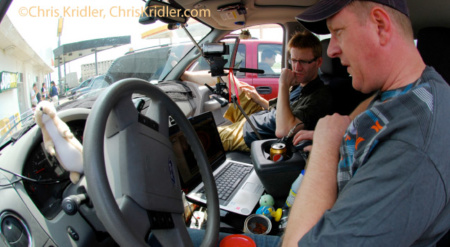
Storm chasers check data while on the road. They usually have lots of gear in their cars for finding and photographing storms. (c) Chris Kridler
After analyzing all the data, a chaser picks a target for where storms might fire. The target may be hundreds of miles away. After breakfast (which may be the last decent meal of the day), chasers often have to drive for hours. If possible, chasers stop again for data. They might find a truck stop with a high-speed wireless Internet connection and sign on to the Internet again, or they might do so through a cellular data connection in their vehicle. Mobile phones and improved data coverage in the Plains have transformed storm chasing.
When online, chasers are looking for all kinds of updates: whether the satellite image shows the bright white, high cloud tops that mean there are blossoming storms; storms on radar; watches and warnings; the latest forecast discussions; and recent surface maps that show any change in temperature, dewpoint or wind direction that indicate where there’s a dryline, cold front or low-pressure system that could kick off storms.
Back in the car, chasers probably make sure their GPS (Global Positioning System) satellite receiver or phone with GPS is working so they can track their location as they move. GPS has mostly replaced old-fashioned maps for many chasers. With the help of software and a cellular data connection, they can see where they are in relation to the storms. The weather radio may be on, as might be radio scanners. Chasers may also use ham (amateur) radio for car-to-car communication.
All this equipment won’t help much if a chaser can’t “go visual” and figure out what the sky means. Chasers look for “towers,” or towering cumulus clouds that can be the first stage in the formation of a supercell (see the tornadoes page). Then they look for other telltale cloud features, and if the storm develops into a tornadic supercell, chasers who choose to play it safe will position themselves ahead of the storm and its hail core – often to the southeast of the storm. If they are northeast of it, they may end up “in the notch” – where they may get a great view as the storm sucks in inflow but may also be in more extreme danger. Sometimes they end up “core punching,” or penetrating the rain and hail core to get to the part of the storm where they can see if a tornado is forming. Punching a core can be very dangerous, because a core can hide a tornado.
“What do you do when you catch one?” many a person has asked. The answer: Take pictures (or observations, if the chaser is a scientist) and stay out of its way.
At the end of a chase day, which usually happens when it gets dark, since storm features (except lightning) aren’t visible then, chasers may end up at a cheap motel late at night, exhausted. They may have driven a few more hours after the storm to get into position for the next day’s chase. If they’re lucky, a decent restaurant is open, and it’s kind of a tradition to have a steak if it was a tornado day. If it was a “bust” day, when they didn’t see any storms, they might get to bed a little earlier. Then, most likely, they look at data again before they go to bed. The last thing they might look at, with bleary eyes, is weather reports or local radar playing on the TV.
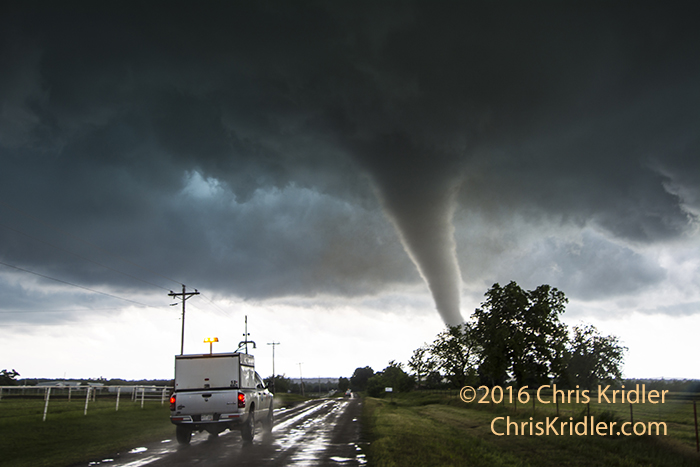
A research vehicle plunges down the road ahead of an Oklahoma tornado on May 9, 2016, to deploy scientific instruments. (c)2016 Chris Kridler
“Twister,” TV, and reality
The huge number of tornado documentaries that have appeared since video cameras became popular raised the profile of storm chasers a little bit. “Twister” raised it a lot.
The 1996 movie depicts two competing teams of storm chasers zooming around Oklahoma during a terrible tornado outbreak. They do a lot of stupid things, and while the movie is very entertaining, it doesn’t resemble reality very much.
For one thing, while the chasers in the movie used a lot of jargon, they rarely used it correctly. That said, a few choice phrases from the movie can now be heard among storm chasers, mostly for their comic value. (“We’ve got cows!” comes to mind.)
Do cows fly? This writer has never seen one do so, but some tornadoes have killed many cattle, leaving corpses strewn over the fields. It wasn’t very funny to the cows.
One of the worst things about how the movie showed the tornadoes is that, in the movie, they tend to form out of plain old stratus clouds. Or sometimes, as in the case of the F5 tornado, the sky is brilliant blue right next to the tornado, when in reality such a large tornado would probably come from a very large supercell that would make the sky dark. In addition, the tornadoes in the movie go from MASSIVE to nothing in about five seconds. In reality, a big tornado would probably weaken and then go into a rope stage, where it stretches out and looks like a snake, before lifting off the ground and dissolving into nothingness.
Another bad thing about the movie was that it made it look as if someone could run away from a giant tornado, then survive it by tying themselves to underground pipes. Don’t count on it. At the very least, the characters of Jo and Bill would have been knocked unconscious and severely wounded by all the debris flying around.
The way the hail looked was inaccurate, too. Hail is usually white or partially clear, or it may be darker if dirt has become frozen into the layers of ice. It’s often round, though it can be bumpy. The hail in the movie looked as if it was taken out of a hotel ice machine.
The science of “Twister” – seen in the instrument packs named “Dorothy” – is based on a real-life experiment. In the 1980s, some researchers from the National Severe Storms Laboratory tried to put a 55-gallon drum equipped with sensors in the path of a tornado. TOTO (Totable Tornado Observatory) never experienced a direct hit by a big tornado.
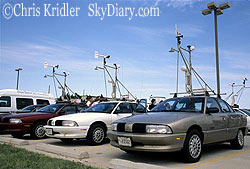
Cars of a mobile mesonet, designed to penetrate storms, carry scientific instruments. (c) 2000 by Chris Kridler
Television shows such as “Storm Chasers,” until recently on Discovery Channel, depict the most exciting parts of the storm chase. Most chasers do not drive armored vehicles into tornadoes, however. Much of chasing is dull and not extreme at all. I made a short video documentary called “Chasing Reality” to show what it’s really like.
Scientists continue to chase storms for a variety of experiments, from VORTEX (Verification of the Origin of Rotation in Tornadoes Experiment) in the mid-’90s to STEPS in 2000 (Severe Thunderstorm Electrification and Precipitation Study). Studies continue, and Doppler on Wheels radar trucks, or DOWs, also can be seen roaming the countryside in search of storms.
Are all chasers as geeky as the chasers in “Twister”? Well … some are geeks, all right. And the author of this Web site counts herself among them.
How to become a storm chaser
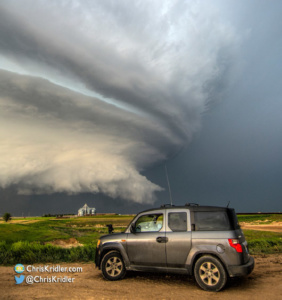
This storm chaser’s car is parked in front of a beautiful supercell in Kansas. (c) Chris Kridler
You shouldn’t become a storm chaser at all unless you’re serious about weather and learn a lot first. Chasing storms can be very dangerous. Chasers worry about more than tornadoes, which usually can be avoided if you know what you’re doing. Wet roads can cause a car to skid; floods can carry automobiles away; big hail can break windshields or cause injury; and lightning can be fatal.
If you want to be a storm chaser, you might want to start by reading as much as you can about weather. There are lots of resources available on the Internet (including some links below). Watch storm videos, as well, to learn what chasers look for and to acquaint yourself with historic tornadoes. Many older chasers grew up with the Tornado Video Classics series from The Tornado Project. You can find many classic tornado videos on YouTube.
Then, try to ride along with an experienced storm chaser for a season, or take a storm chasing tour (a couple are mentioned in the first section). They are a fun, though somewhat expensive, way to get started. And unlike the chasers in charge, you are free to take pictures and admire storms without worrying about driving or booking hotels!
You also can become a storm spotter by taking a Skywarn training course, offered by your local National Weather Service office. It’s a great way to become acquainted with both storm features and dangers and to serve your community.
Above all, be careful. The author of this site does not endorse the idea of all weather enthusiasts driving around in pursuit of storms. Make sure you know what you’re doing first. Don’t stop to get video when your life is in danger. And it is never safe to drive into a tornado. Even one of the tank-like chase cars you see on TV can be tossed by a strong tornado.
“Chasing Reality,” a short documentary about what storm chasing is really like:
Learn more about storm chasing at these sites:
- Storm chasing, frequently asked questions/Roger Edwards and Tim Vasquez
- Storm chasing, frequently asked questions/Chuck Doswell
- “Why Chase Tornadoes?” by David Hoadley
- Stormtrack forum
- Chris Kridler’s Sky Diary – the site that Kidstorm is a part of!
